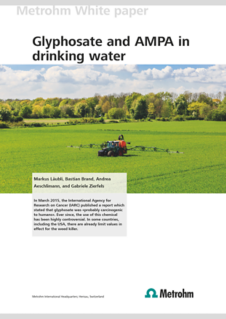Measuring herbicides in drinking water
May 27, 2020
Article
en
How to measure glyphosate in drinking water using ion chromatography.
With springtime come rising temperatures and the increased use of herbicides on agricultural crops and in public spaces. In March 2015, the International Agency for Research on Cancer (IARC) published a report which stated that one such herbicide, glyphosate, was «probably carcinogenic to humans». Ever since, the use of this chemical has been highly controversial. In some countries, including the USA, there are already limit values in effect for the weed killer.
Carcinogenic or not?
Glyphosate is a broad-spectrum herbicide used globally in agriculture. Alongside farming, the chemical is also used to kill weeds in domestic gardens and in public and private spaces kept free from «vegetal invasion», such as railway tracks.
Glyphosate has been used since the 1970's in pesticides and was previously thought to be harmless at typical levels of exposure. However, since the International Agency for Research on Cancer (IARC) – the specialized cancer-research agency of the WHO – found that glyphosate was «probably carcinogenic to humans» (Group 2A) in a report published in March 2015, the chemical repeatedly made headlines [1].
Experts were then divided over whether glyphosate should be reapproved after the expiry of its EU market approval on June 30, 2016. This is because the European Food Safety Authority (EFSA) only recently arrived at the opposed conclusion that it is unlikely that glyphosate is genotoxic or poses a carcinogenic threat [2]. The approval of glyphosate was initially extended by 18 months, but is now allowed to remain in use in the EU until at least the end of 2022 [3].
Determination of glyphosate in drinking water
Because chemicals used in farming can seep through the ground and enter the ground water, limit values are in effect in some countries concerning the concentration of glyphosate in drinking water.
Glyphosate and its metabolite AMPA (aminomethylphosphonic acid) are usually determined by HPLC with post-column derivatization and subsequent fluorescence detection (EPA Method 547), or alternatively by ion chromatography coupled with a mass-selective detector.
Methodology using IC
The following segments explain the initial results of the determination of glyphosate and AMPA in drinking water in the low µg/L range using ion chromatography (IC) with pulsed amperometric detection. The detection limits for glyphosate and AMPA previously attained with pulsed amperometric detection were around ≥ 50 µg/L [4].
Given this improvement in terms of sensitivity, the method outlined here represents a promising approach to the screening of water and food samples for glyphosate and AMPA.
Instrumentation
All determinations were performed with an IC system consisting of a 940 Professional IC Vario ONE with an IC Amperometric Detector and an 858 Professional Sample Processor for automatic sample injection (Figure 1).
Glyphosate and AMPA were separated on the high-capacity anion separation column Metrosep Carb 2 – 150/4.0, and subsequently detected via flexIPAD (FLEXible Integrated Pulsed Amperometric Detection) using a gold working electrode as a measuring mode in the amperometric detector. The profile of the potential curve produced in one measuring cycle in flexIPAD mode is presented in Figure 2.
Experiment
The Metrosep Carb 2 column is used mainly for separating and determining carbohydrates, sugar alcohols, alcohols, etc. Its high column capacity, combined with the high pH value of the eluent (approximately pH 10), results in a large difference in retention time for AMPA and glyphosate. This is because, with a pH value of 10, all three acid groups are deprotonated in part of the glyphosate. This means that it is partially present as a trivalent anion while the metabolite AMPA, which is missing the carboxyl group, is present as a divalent anion.
Results
Figure 3 shows the chromatogram of the determination of AMPA and glyphosate under the conditions used in this application. An aqueous standard solution was injected containing 10 µg/L each of both components.
The detection limits for both components were determined using the signal/noise (S/N) ratio, i.e., the ratio of the peak height to the baseline noise. At the detection limit, the S/N ratio is 3; with smaller values, secured detection is not possible. The detection limit found for AMPA was considerably lower than 1 µg/L, while the limit for glyphosate was approximately 1 µg/L.
Figure 4 shows a chromatogram of a drinking water sample mixed with 2 µg/L glyphosate and AMPA.
Summary
For the first time, glyphosate and its primary metabolite AMPA were determined in drinking water in the low µg/L range using ion chromatography with pulsed amperometric detection (flexIPAD). This puts at our disposal a reliable and – compared with HPLC with a mass-selective detector – very inexpensive method for determining the glyphosate and AMPA content in water and foodstuffs. With a detection limit of approximately 1 µg/L, the adherence to limit values for glyphosate can be verified in the USA, Canada, and Australia, among others.
Your knowledge take-aways
Glyphosate and AMPA in drinking water
References
[1] IARC Monographs Volume 112 (2015). Retrieved from http://monographs.iarc.fr/ENG/Monographs/vol112/mono112-09.pdf on June 27, 2016.
[2] EFSA press news, 151112 (2015). Retrieved from http://www.efsa.europa.eu/en/topics/factsheets/glyphosate151112 on June 27, 2016.
[3] European Commission: Status of glyphosate in the EU. Retrieved from https://food.ec.europa.eu/plants/pesticides/approval-active-substances/renewal-approval/glyphosate_en#status-of-glyphosate-in-the-eu on July 5, 2023.
[4] F. Sanchez-Bayo, R. V. Hyne, and K. L. Desseille (2010) Anal. Chim. Acta, 675 125–131.
 Share via email
Share via email

